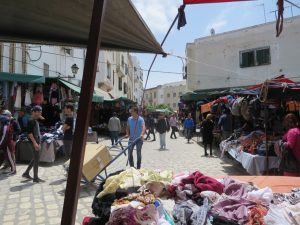July 24, 2023, by lzzre
Counter-histories of urban renewal from Tunis
Participation in a BRISMES panel on ‘Cities: Materiality, Temporality, and Affect’
Katharina Grüneisl is a Research Fellow in the School of Geography at the University of Nottingham and currently conducts research on the used clothing economy in Tunisia and on garment manufacturing in industrial zones in Jordan.
The Annual BRISMES (British Society for Middle Eastern Studies) Conference took place from July 3rd-5th at the University of Exeter, bringing together interdisciplinary scholarship on the Middle East and North Africa under the conference theme “Ecology, Crisis and Power in the Middle East”. Supported by the School of Geography Research Committee of the University of Nottingham, I was able to attend the conference and present my research in the panel ‘Cities: Materiality, Temporality, and Affect’, co-organised by Aya Nassar (University of Warwick) and Sara Salem (LSE).
My conference paper was entitled “The fripisation of the Hafsia: counter-histories of urban renewal from Tunis.” The paper hones in on the Hafsia district in the Tunis medina (old city), which has today become synonymous to the flourishing second-hand trade, locally referred to as ‘fripe’. Innumerable shops, markets stalls and mobile vendors offer diverse second-hand garments, shoes and used objects that are imported to Tunisia from Europe and North America. Despite this omnipresence, the fripe trade remains conspicuously absent from the histories of urban renewal that recount the Hafsia’s successful transformation during one of the largest post-independence urban renewal projects in the capital.
Historically, the Hafsia constituted the Jewish ghetto of Tunis. Overcrowding and dilapidated housing and infrastructure resulted in the out-migration of wealthier Jewish families, transforming the neighbourhood into an arrival site for impoverished rural migrants. Demolition operations – first under the French colonial authorities and then after independence – left gaping holes in its dense urban fabric. This paper explores the role of rural migrants in appropriating these interstices for the auto-construction and consolidation of the first permanent fripe market of Tunis. Based primarily on the life trajectories of individual migrant traders, the paper retraces their agency in shaping the outcomes of urban renewal operations from the 1970s to the 1990s. By honing in on testimonies that complicate or contradict official accounts of urban renewal, the paper constructs counter-histories that unsettle clear-cut differentiations between encroachers and stakeholders, or formal and informal modes of spatial production. Instead, it elucidates the messy processes of co-production and the unanticipated alliances that produced one of the major ‘success stories’ of urban renewal in post-independence Tunis.
No comments yet, fill out a comment to be the first


Leave a Reply